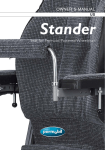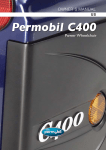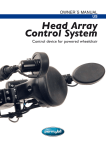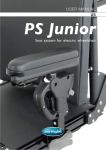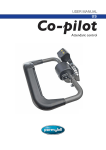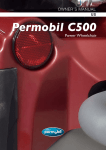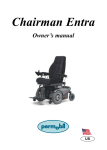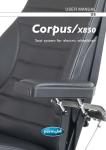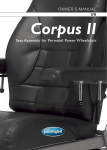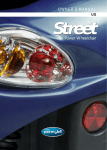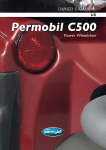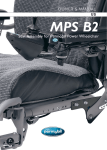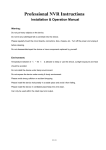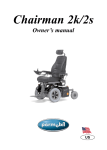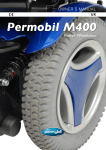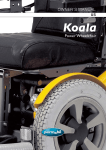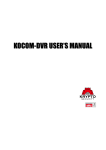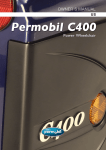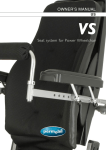Download Permobil user manual
Transcript
OWNER`S MANUAL US Permobil C500 Power Wheelchair How to contact Permobil Permobil Inc. USA 6961 Eastgate Blvd. Lebanon, TN 37090 USA Phone: 800-736-0925 Fax: 800-231-3256 Email: [email protected] Head Office of the Permobil group Permobil AB Box 120, 861 23 Timrå, Sweden Tel: +46 60 59 59 00. Fax: +46 60 57 52 50 E-mail: [email protected] Permobil C500 Power Wheelchair Produced and published by Permobil AB, Sweden Edition: 1, 2004-12 Order no. 205209-US-0 Owner´s Manual Permobil C500 Contents Important Information about the Owner’s Manual ....................................................6 Technical Support ....................................................................................................7 Spare Parts & Accessories......................................................................................7 Scrapping ................................................................................................................7 Warranty ..................................................................................................................7 Safety Instructions ..................................................................................................8-23 Design and Function ....................................................................................................24 General - Overview ................................................................................................24 Seat ........................................................................................................................25 Driving - Shock absorbers .................................................................................... 25 Seat Lift - Seat Tilt ..................................................................................................26 Wheels....................................................................................................................27 Lights, Reflectors ..................................................................................................27 Electrical System - Batteries ............................................................................28-29 Control Panel - Design and Function............................................................................30 Control Panel - Functions ......................................................................................32 Locking - Unlocking the Wheelchair......................................................................34 Seat Control Panel ................................................................................................36 Leverman - Functions ............................................................................................37 Handling ........................................................................................................................38 General - Driving....................................................................................................38 Driving Technique ..................................................................................................39 Driving Rules..........................................................................................................40 Magnetic Wheel Locks ..........................................................................................45 Charging the Batteries.......................................................................................... 46 Transport ......................................................................................................................48 Air Transport ..........................................................................................................50 Maintenance and Repairs ............................................................................................52 Tool Kit....................................................................................................................52 General - Batteries, Storage ..................................................................................53 Finishes Care - Wheels, ....................................................................................54-56 Wheel Lock Release ..............................................................................................57 Changing the Batteries ..........................................................................................58 Circuit Breaker and Charging Fuse ......................................................................60 Technical Specifications................................................................................................62 Data - Electric System ..........................................................................................63 Troubleshooting Guide..................................................................................................64 Error Signals, Electronics ......................................................................................66 Accessories ..................................................................................................................68 Important Information about Electromagnetic Interference (EMI) ..........................70-71 5 Owner´s Manual Permobil C500 Important Information about this Owner’s Manual Important Information about this Owner’s Manual We congratulate you on your choice of power wheelchair. Our goal is for you to continue to feel satisfied with your choice of both vendor and wheelchair. Before you begin using your wheelchair, it is important that you read and understand the content of these operating instructions and in particular the Safety Instructions. These operating instructions are primarily intended to acquaint you with the functions and characteristics of the wheelchair and how you can use them in the best manner possible. They also contain important safety and maintenance information, as well as describing possible problems that can arise while driving the wheelchair. Always keep these operating instructions handy in connection with your wheelchair, since the need for important information can arise concerning its use, safety and maintenance. It is also possible to obtain information concerning our products from our home page on the Internet. You can find us at www.permobil.com. All information, pictures, illustrations and specifications are based upon the product information that was available at the time that these operating instructions were printed. Pictures and illustrations that are found in these operating instructions are representative examples and not intended to be exact depictions of the various parts of the wheelchair. We reserve the right to make changes to the product without prior notice. Ordering of Documentation If you are in need of another copy of the Owner’s Manual, it can be ordered from Permobil, ask for item No. 205209-US-0. 6 Owner´s Manual Permobil C500 Important Information about this Owner’s Manual TECHNICAL SUPPORT In the event of technical problems, you should contact your dealer or Permobil Inc USA at 1-800-736-0925. Always state the chassis serial number when contacting Permobil to ensure that the correct information is provided. SPARE PARTS & ACCESSORIES Spare parts and accessories must be ordered through your dealer. SCRAPPING THE WHEELCHAIR Contact Permobil Inc. for information about scrapping agreements in force. WARRANTY A warranty registration card is attached to each new wheelchair. The Permobil Inc. Product Warranty Information sets forth the conditions of the warranty. Contact your dealer or Permobil Inc USA for information about the warranty period for this wheelchair. 7 Owner´s Manual Permobil C500 Safety Instructions Safety Instructions - General An electric wheelchair is a motorized vehicle and special care must therefore be taken when it is used. Please read and follow all instructions and warnings in this manual before operating your Permobil powered wheelchair. Incorrect use may both injure the user and damage the chair. In order to reduce these risks, you should read the Owner’s Manual carefully, in particular the safety instructions and their warning texts. Throughout this manual the following symbol will be used to note items that have significant importance to safety concerns: ! NOTE Please use caution where this symbol appears. ! WARNING Please use extreme caution where this warning symbol appears. Failure to observe warnings can lead to personal injury and property damage, including damage to the wheelchair. Permobil is not responsible for personal injuries or property damage resulting from any person’s failure to follow the warnings and instructions in this manual. Permobil is not responsible for injuries or damage resulting from failure to exercise good judgment. The final selection and purchasing decision about the type of electric wheelchair to be used is the responsibility of the wheelchair user and his or her healthcare professional. Permobil Inc. is not responsible for inappropriate selections of wheelchair models or features or improper fitting of the wheelchair. 8 Owner´s Manual Permobil C500 Safety Instructions Safety Instructions - General Your wheelchair was configured specifically for your needs as prescribed by your healthcare provider. Consult your healthcare provider before changing the seat position or making any other adjustment. Some adjustments may reduce your wheelchair’s performance or safety or may not be appropriate for your needs. It is also of the utmost importance that you devote sufficient time to become acquainted with the different buttons, the function and steering controls, the different adjustment possibilities of the seat, etc. of your wheelchair and its accessories before you begin using it. Do not undertake your own first test drive without making sure that you have assistance in the immediate vicinity if you should need help. In order to make sure that nothing happened to the wheelchair while it was being shipped to you, you should check the following items before beginning to use it: • that all products ordered are included in the delivery, incuding operating instructions and possible other documentation. If you suspect that something is missing, then contact your supplier or Permobil for more information as soon as possible. • that no transport-related or other damages have occurred to the wheelchair and its accessories. If you discover that something has been damaged or in some other manner appears to be incorrect, then contact your supplier or Permobil for more information as soon as possible before you continue the checks. We recommend that you charge your wheelchair's batteries before you begin using it. The chapter titled ”Charging the Batteries” describes how to do this. Always be sure that tires are inflated properly before driving. If you experience that the wheelchair in any manner is not behaving as expected or if you suspect that something is wrong: abort the test drive as soon as possible, shut off the wheelchair and get in touch with your service contact or Permobil for more information. 9 Owner´s Manual Permobil C500 Safety Instructions Safety Instructions ! WARNING Operation Permobil recommends the use of wheelchair lights at all times user is riding near public rights of way. Use extreme caution when driving near unprotected ledges, drop-offs or on elevated surfaces. Unintended movement or excessive speed in these areas can lead to personal injury or property damage. Do not drive the wheelchair over any curbs or edges higher than 3 inches. When driving over a curb or similarly elevated surface, you must cross the surface at a 90 degree angle (perpendicular). Crossing such surfaces at any other angle may result in the wheelchair tipping. Reduce your speed when driving on uneven terrain or soft surfaces. Do not use your wheelchair on stairs or escalators. Always use an elevator. Do not lift or move the wheelchair by any of its removable parts. Doing so could lead to personal injury and property damage, including damage to the wheelchair. ! NOTE Operation Do not let children drive the wheelchair without supervision. Do not drive the wheelchair on public streets or roadways. Obey all local pedestrian rules and be aware that vehicle drivers may have difficulty seeing you. Do not operate your wheelchair under the influence of alcohol. Consumption of alcohol may impair your ability to operate your wheelchair safely. Some physical limitations or use of medication, either prescribed or over-thecounter, may limit your ability to operate your wheelchair safely. Be sure to consult with your physician about your physical limitations and medications. 10 Owner´s Manual Permobil C500 Safety Instructions Safety Instructions ! WARNING Modifications Any unauthorized modifications to the wheelchair or its various systems may increase the risk of personal injury and property damage, including damage to the wheelchair. All modifications to and interventions in the vital systems of the wheelchair must be performed by a qualified service technician authorized by Permobil to perform such service on Permobil products. Weight Limitations The maximum user weight for your Permobil is set forth in the specification section of the supplied Owner´s Manual for current seat model. Operation of the wheelchair by users who exceed the maximum allowable user weight can lead to personal injury and property damage, including damage to the wheelchair, as well as voiding any applicable warranty to the wheelchair. Do not carry passengers on the wheelchair. Doing so can lead to personal injury and property damage, including damage to the wheelchair. ! NOTE Prior to Riding In some instances, including where certain medical conditions exist, users should practice operating their wheelchair under the supervision of an assistant who is familiar with the operation of the wheelchair and with the abilities and limitations of the user. 11 Owner´s Manual Permobil C500 Safety Instructions Safety Instructions ! NOTE Operation - Inclines When driving downhill, select the slowest speed and proceed with caution. Driving down an incline in a front wheel drive wheelchair can shift the user’s center of gravity forward. If the wheelchair rolls faster than you would like, stop the wheelchair by releasing the joystick and begin descending again at a slower speed. Avoid sudden stops or starts. Stop by releasing joystick rather than by turning the power off. Turning off power while the wheelchair is in motion will cause the wheelchair to stop suddenly. Be sure to keep all recommended positioning belts securely fastened at all times. When driving up an incline, try to keep moving at a steady speed. Stopping and starting the chair while moving up an incline makes the wheelchair more difficult to control. Do not drive up or down slopes with a gradient greater than indicated in the technical specifications section of the manual. There is a risk that the wheelchair will not maneuver safely. 12 Owner´s Manual Permobil C500 Safety Instructions Safety Instructions ! WARNING Operation - Inclines Do not drive the wheelchair where the sideways gradient is more than indicated in the technical specifications section of the manual. There is a risk of tipping over. Do not drive up or down ramps that are not equipped with proper edge protection along the sides of the ramp to prevent the wheelchair from falling off of the ramp. When driving up an incline, be sure to drive your wheelchair straight up the incline (perpendicular). Driving at an angle up an incline increases the risk of tipping or falling. Use extreme caution when driving up an incline. Do not drive down or up a hazardous incline, such as a surface covered with snow, ice, or wet leaves or a surface that is uneven. Also avoid driving on ramps that do not have proper edge protection. 13 Owner´s Manual Permobil C500 Safety Instructions Safety Instructions ! WARNING Operation - Turning Turning your wheelchair at high speeds can create the possibility of the wheelchair tipping and personal injury. The possibility of tipping can be increased by high turning speed, sharp turns, uneven surfaces, abrupt changes in direction, and driving from an area of low traction (e.g. lawn) to an area of high traction (e.g. sidewalk). To protect against tipping, personal injury and property damage, reduce speed and reduce the sharpness of your turn when turning. Operation - Freewheel Mode In order to prevent the wheelchair from rolling away, ensure that the wheelchair is on a level and dry surface before releasing the brakes. In order to avoid personal injury do not use your Permobil in freewheel mode without an attendant present. Do not attempt to put the wheelchair in freewheel mode by yourself while seated in it. Do not put the wheelchair in freewheel mode while on an incline. This could cause the wheelchair to roll on its own, causing injury and property damage, including damage to the wheelchair. 14 Owner´s Manual Permobil C500 Safety Instructions Safety Instructions ! NOTE Driving on a Loose or Soft Surface When the wheelchair is set to its lowest speed and the batteries are not fully charged, driving on certain surfaces, for example gravel, sand or thick carpeting, can involve constrained navigability. Driving in Darkness Driving in the dark may only be done if your wheelchair is equipped with functioning lighting in the front and the back, or as per the applicable national or local traffic regulations. Driving in Extreme Climate Conditions Permobil's wheelchairs are designed to withstand most adverse weather conditions, however to minimize the risk of being caught in difficult situations you should avoid using the wheelchair outdoors during, for example, severe cold, heavy rain or thick snow. Also bear in mind that certain surfaces on the wheelchair can be heated up or cooled down in the event of prolonged exposure to intense sunlight or cold respectively. 15 Owner´s Manual Permobil C500 Safety Instructions Safety Instructions ! WARNING Driving with Seat Lift/Seat Tilt/Backrest Recline Be careful in making sure that nothing gets stuck between the chassis and the seat when the seat lift/seat tilt is operated. Operating the seat lift,seat tilt/ backrest recline changes the center of gravity and increases the risk of tipping over. Always drive in low speed and only use those seat functions on level ground, and not on hills, ramps, slopes or other inclines. Using those seat functions while driving on inclines can lead to personal injury and property damage, including damage to the wheelchair. Center of Balance The possibility of this wheelchair tipping and the point where this wheelchair will tip forward, back or to the side depends on its center of balance. Please note that the following factors can affect the wheelchair’s center of balance: • • • • • Elevation of the seat Height and angle of the seat/backrest Body position or weight distribution Driving on an incline such as a ramp or a hill Use of a backpack or other accessories, depending on the amount of weight added. If your wheelchair begins to move in an unexpected manner, immediately release the joystick to stop the wheelchair. Except in an emergency, do NOT use the on/off button to stop your wheelchair. This will cause the wheelchair to stop abruptly and may cause personal injury. 16 Owner´s Manual Permobil C500 Safety Instructions Safety Instructions ! WARNING Positioning Belt Permobil positioning belts are designed to position the user only and will not protect you in an accident. You may even receive further injury from the belts. Support Wheels If your wheelchair is equipped with support wheels, they must always be mounted when the wheelchair is being driven. Transfer into and out of the chair Be sure that the power is turned OFF before entering or leaving the wheelchair and before lifting the control side armrest. When transferring into or out of the wheelchair, every precaution should be taken to reduce the distance between the wheelchair and the place to which the user is transferring. Overextending this distance can cause user to overexert, lose balance, or fall. Permobil recommends that users transfer in the presence of or with the assistance of an attendant. Use caution when bending or reaching. Never use the joystick as a handhold or point of support. Do not use foot plates or armrests as supports when transferring into or out of the wheelchair. The footplates and armrests are not designed to be weightbearing structures. Excessive force may cause them to give way, resulting in personal injury or property damage, including damage to the wheelchair. 17 Owner´s Manual Permobil C500 Safety Instructions Safety Instructions ! WARNING Passengers The wheelchair is not intended to transport passengers, regardless of the age of the passenger. The Maximum User Weight stated in the Owner's Manual for your seating includes the user and any personal effects. The Maximum limit should not be exceeded. The wheelchair's maneuverability and stability can be degraded as a result. Environmental Conditions Protect your wheelchair from exposure to any type of moisture, including rain, snow, or wash. Exposure to moisture can caused the chair to short-circuit, catch fire and cause personal injury or property damage. Do not operate your wheelchair if it has been exposed to moisture until it has dried completely. If any of the shrouds or the joystick boot has cracks or tears, they must be replaced immediately. Failure to do so can allow moisture to enter the electronics and cause personal injury or property damage, including fire. Do not operate your wheelchair in icy or slippery conditions. These conditions can lower the performance and safety of your wheelchair which could lead to an accident, personal injury and property damage, including damage to the wheelchair. NOTE: Extreme care should be exercised when using oxygen in close proximity to electric circuits and other combustible materials. Contact your oxygen supplier for instruction in use of oxygen. 18 Owner´s Manual Permobil C500 Safety Instructions Safety Instructions ! WARNING Transport The wheelchair must be transported in or with transport solutions that have been approved for this purpose. Check that the wheelchair is properly secured and that the wheel locks are not disengaged. The wheelchair can be locked into position by running fastening straps through the brackets at the front and back. Also check that the fastening points on the transport vehicle are well-anchored. A defectively fastened chair can cause serious injury to persons in the vehicle and serious damage to the vehicle. Use Prohibited in Motor Vehicles Currently, the Department of Transportation has not approved any tie-down or restraint system in a moving vehicle of any type to transport a person while seated in a wheelchair. Permobil recommends that users NOT be transported in any kind of vehicle while in their wheelchair. The only safe alternative is that users be transferred into factory vehicle seating for transportation and use safety restraints made available by the auto industry. Permobil does not recommend any wheelchair transportation systems. Never sit in your wheelchair while in a moving vehicle. In an accident or sudden stop you may be thrown from the chair and seriously injured or killed. Permobil positioning belts are designed to position the user only and will not protect you in an accident. You may even receive further injury from the belts. 19 Owner´s Manual Permobil C500 Safety Instructions Safety Instructions ! WARNING Maintenance and Service Carry out only the service and maintenance which are stated in the Owner’s Manual. All other service and maintenance must be performed by a qualified service technician authorized by Permobil to perform such service on Permobil products During all work on the electrical system of the wheelchair, the Circuit Breaker must always be in OFF position. To avoid the risk of electric shock, use extreme caution when using metal objects while working on the batteries. Short-circuiting can easily cause an explosion. Never perform service on the wheelchair without using protective gloves and goggles. Failure to do so can lead to personal injury. Do not use parts or accessories not authorized by Permobil. Use of unapproved ”aftermarket” accessories and parts may cause changes in the wheelchair, which may make the wheelchair unstable or uncontrollable. Such use may also void the warranty on the wheelchair. Connecting any unapproved electrical or electronic devices to the wheelchair’s electrical system can cause damage to the chair and caused the chair to become uncontrollable or drive erratically. Such use may also void the warranty. The wheelchair is heavy and contains many moving parts, which means that the risk of being caught between them is always present. Charging of Batteries Charging must be done in a well-ventilated room, not in a wardrobe or closet. Charging must not be done in a bathroom or wet room. Only chargers with a max 10 A charging current (average value) may be used (the RMS value of the charging current must not exceed 12A). When the charger is connected, the chair must not and cannot be driven. 20 Owner´s Manual Permobil C500 Safety Instructions Safety Instructions ! WARNING Safety Circuits Permobil products are equipped with safety circuits. Inhibit circuits prevent the wheelchair from driving under certain conditions. Speed reduction circuits limit the wheelchair’s maximum speed under certain conditions. Limit switch circuits limit the wheelchair’s functions under certain circumstances. Overload protection circuits shut the wheelchair off in case of an overload. The user should stop using the wheelchair immediately and consult an authorized Permobil distributor if any of these circuits should become disabled. Any attempt to modify the safety circuits will result in unsafe operation of the wheelchair and could cause the chair to become unstable or uncontrollable. Such modifications may also void the wheelchair’s warranty. Changing Batteries and Fuses The Circuit Breaker must always be in OFF-position when batteries and fuses are replaced. Observe care in the use of metallic objects when working with batteries. A short-circuit can easily cause an explosion. Always use protective gloves and protective eye-glasses. Filling Air into tires Check at regular intervals that the wheelchair's tires have the prescribed tire pressure. Incorrect tire pressure can cause deteriorating stability and maneuverability. The prescribed tire pressure is 29 psi (200 kPa). Note that overfilling causes a risk of explosion. 21 Owner´s Manual Permobil C500 Safety Instructions Safety Instructions ! WARNING Changing Tires Avoid the use of sharp-edged tools when working with tires. If the wheel bolt is removed for tire service, replace it with a new, unused part from Permobil and tighten the bolt to the recommended torque. Also, inspect the drive axle and wheel rim for any damage. Damage to either part can cause the wheel bolt to loosen or fracture. Permobil recommends that wheel bolts be used only one time. Storage The wheelchair and its accessories must always be shut off when they are not being used. Always store the wheelchair so that access for unauthorized individuals is avoided. Never store the wheelchair in a room in which condensation can arise (mist or dampness on the surfaces) e.g. in pool areas, laundry rooms, or similar rooms. If you are unsure as to how your wheelchair and its accessories should be properly stored, contact your supplier or Permobil for more information. Damages/malfunctions on the wheelchair and its accessories If you experience that the wheelchair in any manner is not behaving as expected or if you suspect that something is wrong: Stop driving as soon as possible, shut off the wheelchair and contact your service contact or Permobil for more information. It’s also of greatest importance that Permobil be informed if the wheelchair and its accessories have been subjected to transport damages, damages during driving or damages due to another cause as soon as possible after the event. There exists a risk that the wheelchair and its accessories can no longer be used in a safe and secure manner. 22 Owner´s Manual Permobil C500 Safety Instructions Safety Instructions ! NOTE Recycling of Batteries Used or broken drive batteries should be taken care of in an environmentally correct manner in accordance with locally applicable recycling directions. EMC Requirements The electronics of an electrical wheelchair can be affected by external electromagnetic fields (for example from mobile telephones). Similarly, the electronics of the wheelchair itself can also emit electromagnetic fields that can affect the immediate surroundings (for example certain alarm systems in businesses). The limit values for Electromagnetic Compatibility (EMC) with respect to electrical wheelchairs is set in the harmonized standards for the EU in the Medical Devices Directive, No. 93/42/EEC. Permobil's electronic wheelchair’s comply with these limit values. Also see Important Information about Electromagnetic Interference (EMI) on page 70-71. 23 Owner´s Manual Permobil C500 Design and Function Design and Function General The Permobil C500 is a power wheelchair for outdoor and indoor driving intended for persons with functional impairments. The wheelchair consists of a chassis and a seat. The seat consists of the seat frame, seat plate/backrest, armrest/legrest, seat lift/fixed seat and possible accessories and additional options such as a headrest, calf rest, chest support, etc. In these operating instructions, we have chosen to show the wheelchair with our Corpus II seat. The management of the chassis and most of its functions are, however, the same regardless of which seat model is selected. Overview 1 2 9 3 8 4 7 5 6 1. 2. 3. 4. 5. Backrest Control Panel Seat Legrest Footplate 6. 7. 8. 9. 24 Front Wheel (drive wheel) Rear Wheel Chassis Armrest Owner´s Manual Permobil C500 Design and Function Seat The Permobil C500 can be combined with different seat models, which are supplied with separate operating instructions. Driving The wheelchair has a drive pack for each drive wheel. The motors regulate the speed, turning and braking. A joystick on the control panel sends signals to the electronics unit. The electronics unit then controls the motors. Shock Absorbers The wheelchair is fitted with two shock absorbers, with adjustable spring force. If the weight of the user is not specified, the wheelchair is supplied with the shock absorbers set to a standard value, which is correct for a user from 110 – 154 lbs. Adjusting Spring Force Adjustments should be made by someone familiar with the design and operation of the shock absorbers. When adjustment is required, contact your nearest service engineer/service center or Permobil. Shock Absorber Electric Motor Driving Gear 25 Owner´s Manual Permobil C500 Design and Function Seat Lift The Permobil C500 can be fitted with an electrically controlled seat height adjuster. An actuator device which is controlled from the maneuvering panel makes it possible to raise the seat up to 7 3/4” to adapt the height to tables, benches, etc. If the seat lift is raised from its lowest position, the wheelchair's maximum speed is reduced. Seat Tilt The Permobil C500 can be fitted with an electric seat tilt actuator adjuster, which lets you adjust the angle of the seat. The electric seat tilt actuator is controlled from the control panel or from the seat control panel. Seat Lift Seat Tilt 26 Owner´s Manual Permobil C500 Design and Function Wheels The front wheels have pneumatic tires and the rear wheels can have either pneumatic or solid rubber tires. Lights and Reflectors In the standard version the wheelchair is equipped with reflectors in the front and back as well as on the sides. Front/back lights and flashing indicators are available as accessories Two Front Reflectors Two Rear Reflectors Two Side Reflectors 27 Owner´s Manual Permobil C500 Design and Function Electrical system Circuit Breaker Permobil C500 is equipped with a 63A (C500) or 80A (C500s) automatic Circuit Breaker, which can be reset after having been triggered. The Circuit Breaker is located in an outlet on top of the rear chassis. Charging Fuse 15A/Charging Socket The Charging Fuse is located under the rear chassis cover and the Charging Socket is located in an cutout up on the right side at the rear end of the chassis cover and is covered by a rubber protection. Circuit Breaker ! Charging Fuse 15A Charging Socket NOTE Always shut off the Power Supply on the Control Panel before switching off the Circuit Breaker. ! WARNING A triggered automatic Circuit Breaker can indicate larger electrical faults. The cause should be checked carefully before the circuit breaker is reset. Always contact an authorized serviceman or Permobil when in doubt. ! WARNING Always shut off the Power Supply on the Control Panel before changing the Charging Fuse. The battery charger must not be connected when the Charging Fuse is replaced. A triggered Charging Fuse can indicate a problem or defect with batteries, charger, charger cables or the wheelchair's charging socket. The cause of a triggered Charging Fuse should be carefully checked before the fuse is replaced. 28 Owner´s Manual Permobil C500 Design and Function Electrical System Battteries The wheelchair's two batteries are located under the rear end of the chassis cover. Both of the batteries are easily accessible for maintenance and battery replacement. Location of the Batteries ! NOTE Used or broken drive batteries should be taken care of in an environmentally correct manner in accordance with locally applicable recycling directions ! WARNING Observe care in the use of metallic objects when working with batteries. A short-circuit can easily cause an explosion. Always use protective gloves and protective eye-glasses. The batteries are heavy and must be handled with care. 29 Owner´s Manual Permobil C500 Design and Function Control Panel The Control Panel consists of a joystick, function buttons and indicator lights. Your wheelchair may also be equipped with an extra Seat Control Panel in addition to the control panel. You can choose whether you wish to control the electrical seat functions from the seat control panel or from the control panel. Control Panel Overview Function Buttons/Indicator Lights Joystick Seat Control Panel 30 Owner´s Manual Permobil C500 Design and Function Function Buttons/Indicator Lights On the control panel there are a total of 7 function buttons and a total of 3 indicator lights. Function Buttons Power Switch, on/off Warning Light Lighting (option) Left Turn Indicator Right Turn Indicator ”MODE” Selector Signal Indicator Lights Battery Voltage Indicator Speed Indicator 31 Seat Indicator Owner´s Manual Permobil C500 Design and Function Panel Display for Control Panel JSM-L 7key Pilot+ NOTE! If your wheelchair is not equipped with lights (option) the push buttons for lights and turning indicators have no function. However the turning display lamps on the control panel flash when the warning button is activated. Overview Panel Display Power Switch, On/Off Warning Symbol Button to power up and power down the wheelchair. This button must have been pressed for the chair to operate. When you press the switch, the indicators lamps for warning symbol (red lamp) and for both indicator lights (green lamp) flash on the control panel. If your wheelchair is equipped with lights, the turning indicators on the chassis also flash to attract attention. NOTE! This function works even when the start button is switched off. ! WARNING Do not use the Power Switch Button to stop the wheelchair unless there is an emergency. If you do, you may get thrown out of the chair or shorten the life of the wheelchair drive components. Turning Indicators MODE (selector) Pressing the right or left arrow activates the wheelchair’s turning indicators. Activates the speed indicator and electric seat functions. 32 Owner´s Manual Permobil C500 Design and Function Lights (option) Warning Horn Press the switch to turn on the lights of the wheelchair. Press the button to sound the horn and attract attention. Seat Function Indicator Speed Display Indicates active seat function when Leverman is used. Indicates the adjusted speed at which the wheelchair is set. 1 - 2 lamps = Low speed 3 - 4 lamps = Medium speed 5 lamps = Maximum speed Battery Voltage Indicator The battery voltage indicator lets you know how much charge is left in your batteries The window display on the control panel shows the following indicator lights (from bottom to top): drive your wheelchair. Like the fuel gauge in a car, it is not completely accurate, but will help you avoid running out of ”fuel”. The indicator gives you a more accurate reading about a minute after you start driving the wheelchair. Red+Yellow+Green = Fully charged Red+Yellow = Half charged Red = Charge the batteries The voltage indicator also serves as a ”fault indicator” for the wheelchair’s electronic system. See page 66 for more information. The best way for you to use the indicator is to learn how it behaves as you 33 Owner´s Manual Permobil C500 Design and Function Locking/Unlocking the Wheelchair Wheelchairs with Pilot+ control system are equipped with a security key which can be used to lock the wheelchair to prevent unauthorized use. To lock the wheelchair: Make sure the wheelchair is switched On. The key should then be inserted into and withdrawn from the panel outlet. The wheelchair will now be locked. To unlock the wheelchair: To unlock the wheelchair, switch it On. The maximum speed indicator will ripple up and down but driving will not be possible. The key should now be inserted into and withdrawn from the panel outlet. The wheelchair can now be driven. Panel Outlet with Security Key 34 Owner´s Manual Permobil C500 Design and Function Joystick The primary function of the joystick is to control the speed and direction of the wheelchair. The further you push the joystick from the center position, the faster the wheelchair will move. When you release the joystick the brakes are automatically applied. If the wheelchair is fitted with actuators, the joystick can also be used to select and move actuators, see page 37. Joystick 35 Owner´s Manual Permobil C500 Design and Function Seat Control Panel With this panel, the wheelchair’s electrical seat functions are controlled. NOTE! The number of available functions and their position on the panel, can vary depending on how your wheelchair is equipped. 1 2 3 4 1. Seat Lift The seat is raised when the top part of the seat lift button is pressed, and lowered when the bottom part of the button is pressed. 3. Seat Tilt The seat is angled backwards when the bottom part of the seat tilt angle button is pressed, and move forwards when the top part of the button is pressed. 2. Backrest Recline The backrest is tilted backwards when the bottom part of the backrest angle button is pressed and forwards when the top part of the button is pressed. 4. Legrest The legrest moves forwards when the top part of the leg support button is pressed, and backwards when the bottom part of the button is pressed. 36 Owner´s Manual Permobil C500 Design and Function Leverman (Joystick Manager) With the help of Leverman, you can set the maximum speed of the wheelchair and also control the electric seat functions. Speed Selector Press MODE button once. The speed indicator lights flash and by moving the joystick to the right/left you can increase/decrease the maximum speed of the wheelchair. - Confirm your setting and return to drive by pressing the MODE button twice or move on to next step by one press. NOTE! If the joystick is moved forwards/backwards during setting of the maximum speed, the chair will go back to drive mode using the present speed range. Legrest Press MODE button twice. The right footplate indicator lamp is lit. Move the joystick forward/backwards to move the legrest out or in. - Make your adjustment and return to drive by pressing the MODE button once or go on to next step by moving the joystick to the right. Seat Lift/Seat Tilt/Backrest Press MODE button twice. The right footplate indicator lamp is lit. By moving the joystick to the right or left you can now select desired seat function and make your adjustments by moving the joystick forward/backward. - Return to drive by pressing the MODE button once. MODE Button Speed Indicator Legrest active Seat Lift active SeatTilt active Backrest Recline active 37 Owner´s Manual Permobil C500 Handling Handling General The Wheelchair is designed for indoor and outdoor use. When driving indoors, you must observe care when driving in, for example, narrow passageways, when passing through doors and entries as well as when using elevators, ramps, etc. Also be conscious of the risk of things getting caught in the machinery when you use the electrical seat lift and seat tilt, in particular when the wheelchair has been run in under a table, workbench or the like. Outdoors, you must remember to drive very slowly on steep downhill slopes and to observe great care when driving on uneven foundations, on uphill slopes, with sideways slopes and when negotiating obstacles. Always maintain a safe distance from the edge when driving close to drop-offs and precipices and drive using the lowest speed possible for the terrain. We recommend that you make repeated test drives in surroundings in which you know you feel secure so that you are quite familiar with how the wheelchair and its accessories behave in different situations before you begin using the wheelchair in public areas. Driving - General Make sure that the control system is mounted securely and that the joystick position is correct. The hand or limb you use to operate the joystick should be supported, for example by the wheelchair arm pad. Do not use the joystick as the sole support for your hand or limb - wheelchair movements and bumps could upset your control. 1. Switch on the power by pressing the start button on the control panel. 2. Set an appropriate maximum speed by first pressing the “MODE” button and then selecting the speed with the joystick until the desired indicator lamp lights up for your type of driving. It is preferable to begin with a low speed. Then press the ”MODE” button twice or activate the joystick forward in order to return to driving. 3. Carefully move the joystick forward to drive forward, and backward to drive backward. 4. The speed of the wheelchair is adjusted continuously by the joystick being moved different distances forward and backward respectively. The wheelchair's electronics make creep driving possible over edges (max. 3 in.) You can drive up to the edge, and then carefully drive over it. 38 Owner´s Manual Permobil C500 Handling Driving Technique The control system interprets your joystick movements and produces appropriate movements of your wheelchair. You will need very little concentration to control the wheelchair, which is especially useful if your are inexperienced. One popular technique is to simply point the joystick in the direction you want to go. The wheelchair will ”home-in” on the direction you push the joystick. Always think about driving as flexibly as possible and avoid severe braking and avoidance maneuvers. DRIVING FORWARD TURNING RIGHT TURNING LEFT DRIVING BACKWARD ! NOTE Do not perform the first test drive on your own. The test drive is of course just a check of how you and the wheelchair function together, and you may need some assistance. Before driving, check that the wheel lock is set in the drive position. ! WARNING Do not use the joystick as the sole support for your hand or limb - wheelchair movements and bumps could upset your control Always bear in mind that a high speed and extended braking distance entail an increased risk of accidents. We recommend the use of a positioning seat belt when driving the Permobil C500. In the event of the wheelchair moving in an unexpected way, RELEASE THE JOYSTICK! This action should stop the wheelchair under any circumstances. 39 Owner´s Manual Permobil C500 Handling Driving Rules Support Wheels Your wheelchair can be equipped with support wheels mounted at the front to minimize the risk of the wheelchair tipping over forward when passing obstacles and the like. If your wheelchair is equipped with support wheels, they must always be mounted when the wheelchair is being driven. Front Support Wheels ! WARNING The front support wheels (if equipped) must always be mounted when the chair is being driven. There is a risk of tipping. Always bear in mind that high speed and extended braking distance entail an increased risk of accidents. We recommend the use of positioning belt (option) when seated in your powered wheelchair. Never drive rapidly or at full speed along narrow passages, on narrow sidewalks, etc. where an incorrect maneuver or incorrect steering can cause an increased risk of accidents. Always drive at low speed on uneven surfaces. Keep in mind that driving along slopes will have an effect on the wheelchair and could make it steer to the side. Never drive at full speed along slopes. Use of the seat lift, backrest/seat tilt function displaces the center of gravity, which can have a negative effect on the chair’s handling characteristics while it is being driven. So you should never drive at full speed if an extreme backrest/seat tilt is being used. 40 Owner´s Manual Permobil C500 Handling Driving over Obstacles Do not drive the wheelchair over obstacles of a height greater than 3 inches. Driving over tall edges increases the risk of tipping over as well as the risk of damage to the wheelchair. Negotiating obstacles must always be done with great care. Max 3 in. ! WARNING Do not drive the wheelchair over obstacles of a height greater than 3 inches. Negotiating obstacles must always be done with great care. ! WARNING Operating the seat lift, seat tilt, backrest recline changes the center of gravity and increases the risk of tipping over, hence those seat functions shall only be used on level ground, driving in low speed with great caution. 41 Owner´s Manual Permobil C500 Handling Driving on Downhill Slopes Driving on downhill slopes must always be done at a low speed and with great care. Avoid rapid braking, abrupt avoidance maneuvers and never maintain a speed higher than that at which you can maneuver the wheelchair in a safe and secure manner. When driving on downhill slopes with an uneven surface (for example grass, gravel, sand, ice or snow) a great deal of extra care must be observed. Max 12°*) ! WARNING Do not drive down a downhill slopes with a slope of greater than 12 degrees. *) Dynamic stability according to ISO 7176-2= 6°. ! WARNING Operating the seat lift, seat tilt, backrest recline changes the center of gravity and increases the risk of tipping over, hence those seat functions shall only be used on level ground, driving in low speed with great caution. 42 Owner´s Manual Permobil C500 Handling Driving on Uphill Slopes Driving on uphill slopes must always be performed with great care. Avoid abrupt avoidance maneuvers and never maintain a speed higher than that at which you can maneuver the wheelchair in a safe and secure manner. When driving on uphill slopes with an uneven surface (for example grass, gravel, sand, ice or snow) a great deal of extra care must be observed. Max 12°*) ! WARNING Do not drive up an uphill slope of greater than 12 degrees. *) Dynamic stablility according to ISO 7176-2= 6°. ! WARNING Operating the seat lift, seat tilt, backrest recline changes the center of gravity and increases the risk of tipping over, hence those seat functions shall only be used on level ground, driving in low speed with great caution. 43 Owner´s Manual Permobil C500 Handling Driving with Sideways Slopes Driving with a sideways slope must always be performed with great care. Avoid abrupt avoidance maneuvers and never maintain a speed higher than that at which you can maneuver the wheelchair in a safe and secure manner. When driving on sideways slopes with an uneven surface (for example grass, gravel, sand, ice or snow) a great deal of extra care must be observed. Max 10° ! WARNING Do not drive the wheelchair on sideways slopes of greater than 10 degrees. There is a risk of tipping over. ! WARNING Operating the seat lift, seat tilt, backrest recline changes the center of gravity and increases the risk of tipping over, hence those seat functions shall only be used on level ground, driving in low speed with great caution. 44 Owner´s Manual Permobil C500 Handling Manual Handling of the Magnetic Wheel Locks The magnetic wheel locks can be released to make it possible to move the wheelchair manually. The wheel lock lever is located at the front of the right wheel cover. Releasing the Wheel Locks 1. Switch off the wheelchair with the On/Off button on the control panel. 2. Move the lever upwards to release the wheel locks. Hold the lever up as you simultaneous press the lever safety catch to the right to secure the lever. The wheelchair can now be moved manually. Engage the Wheel Locks 1. Move the lever upwards to release the lever safety catch. The wheel lock lever will automatically move down to lock position. Released Wheel Locks with Security Catch ! Engaged Wheel Locks WARNING Do not use the wheelchair on hilly slopes with the wheel lock in free-wheel position. Do not engage or disengage wheel locks unless power to the wheelchair is off. In order to avoid the wheelchair rolling away, ensure that the wheelchair is on a level and dry base before releasing the wheel locks. Be aware that the wheelchair will not have brakes when wheel locks are in the free-wheel position. Make sure that the person pushing the wheelchair has full control when wheel locks are disengaged. Always make sure that the wheel locks are engaged after manually moving the wheelchair. ! NOTE When the wheel locks are released, the chair will not drive. If it does, contact your Permobil serviceman as soon as possible. 45 Owner´s Manual Permobil C500 Handling Battery Charging The amount of charge in your batteries depends on a number of factors, including the way you use your wheelchair, the temperature of the batteries, their age and the way they are made. These factors will affect the distance you can travel in your wheelchair. All wheelchair batteries will gradually lose their capacity as they age. The most important factor that reduces the life of your batteries is the amount of charge you take from the batteries before you recharge them. Battery life is also reduced by the number of times you charge and discharge the batteries. To make your batteries last longer, do not allow them to become completely discharged. Always recharge your batteries promptly after they are discharged. If your battery gauge reading seems to fall more quickly than usual, your batteries may be worn out. ! NOTE If the batteries should be drained completely, it is important that you charge them up again as soon as possible since a complete loss of charge reduces the lifespan of the batteries. ! WARNING Observe care in the use of metallic objects when working with batteries. A short-circuit can easily cause an explosion. Always use safety gloves and protective eye-glasses. Only chargers with a max 10 A charging current (average value) may be used. (The RMS value of the charging current must not exceed 12A.) Charging must be done in a well-ventilated room, not in a wardrobe or closet. Charging must not be done in a bathroom or wet room. The charger's charging cable must not be extended. The charger can become hot and hence must not have anything covering it. The charger must be positioned so that there is an air gap on all of its sides, including below (do not set the charger on thick carpeting, for example). The charger contact must be replaced if it is damaged or becomes hot during charging. Both the contact on the charger's cord and the wheelchair's charging outlet should be replaced if one of them is damaged or worn. Replacement must be performed by qualified personnel. 46 Owner´s Manual Permobil C500 Handling Charging 1. Loosen the charging sockets round rubber protection and connect the charger plug into the battery charging socket up on the right side at the rear end of the chassis cover. 2. Connect the charger to the 110 volt supply and turn on the power for the charger. Description and Use of Battery Charger, see supplied Owner’s Manual. ! NOTE Ensure that the charger plug is pushed fully in position. You will not be able to drive the wheelchair when the charger is connected. If the wheelchair does drive with the charger plugged in, contact your Permobil serviceman as soon as possible. ! WARNING Only use the battery charger that has been supplied with your wheelchair or recommended by Permobil. The use of incorrect chargers could damage the batteries, wheelchair, control system or charger itselt, or may result in parts overheating creating the potential for burns or even fire. To avoid sparking and unnecessary wear and tear of the wheelchair’s charging socket, be sure that the main voltage and the charger is in OFF position when connecting/disconnecting the charging cable to the wheelchair’s charging socket. Charger Connection 47 Owner´s Manual Permobil C500 Transport Transport The wheelchair must only be transported in a vehicle that is approved for such purposes. Check that the wheelchair is properly fastened and that the wheel locks are engaged. The wheelchair can be locked into position by running fastening straps through the brackets in the front and the back, each marked with a yellow sticker. Secure the wheelchair according to the manufacturer of the vehicle restraint systems instructions. Always make sure that the fastening points on the transport vehicle are well-anchored. ! NOTE If your wheelchair is equipped with a Luggage Box (option) difficulty may occur to anchor the wheelchair at the rear fastening brackets. This can be solved by ordering an extra pair of Rear Fastening Brackets. Please contact Permobil or your nearest dealer for more information and how to order. 8533 Front Fastening Brackets Sticker 48 Rear Fastening Brackets Owner´s Manual Permobil C500 ! Transport WARNING Use Prohibited in Motor Vehicles Currently, the Department of Transportation has not approved any tie-down or restraint system in a moving vehicle of any type to transport a person while seated in a wheelchair. Permobil recommends that users NOT be transported in any kind of vehicle while in their wheelchair. The only safe alternative is that users be transferred into factory vehicle seating for transportation and use safety restraints made available by the auto industry. Permobil does not recommend any wheelchair transportation systems. Never sit in your wheelchair while in a moving vehicle. In an accident or sudden stop you may be thrown from the chair and seriously injured or killed. Permobil positioning belts are designed to position the user only and will not protect you in an accident. You may even receive further injury from the belts. When transporting the wheelchair in a vehicle, ensure that the wheelchair is properly secured. If the chair is not properly secured and comes loose, it can cause serious injury to persons in the vehicle and serious damage to the vehicle. If the wheelchair has to be transported with the user in the chair into the vehicle through a ramp, the wheelchair shall be secured against tipping backwards by a person behind. Wheelchair users should transfer to the vehicle seat and use the vehicle-installed restraint system whenever it is feasible. The vehicle restraint belt should not be worn twisted. Always make sure that the vehicle restraint belt is not adjusted over sharp edges of the wheelchair. The vehicle restraint belt should not be held away from the body by wheelchair components or parts, such as the wheelchair’s armrest or wheels. All wheelchair-mounted trays shall be removed and secured separately in the vehicle, or be secured to the wheelchair. When possible, other auxiliary wheelchair equipment should be either secured to the wheelchair or removed from the wheelchair and secured in the vehicle during transit, so that it does not break free and cause injury to vehicle occupants in the event of a collision. A poorly fastened chair can cause extensive damage and injury both to the people in the transport vehicle as well as to the vehicle itself and the wheelchair if it comes loose. 49 Owner´s Manual Permobil C500 Transport General Advice for Air transport Please refer to the Air Carrier Access Act at 49 USC § 41705 and accompanying regulations at 14 CFR Part 482 for specific guidelines and regulations pertaining to transporting wheelchairs on aircraft in the United States. Further guidelines on transporting powered wheelchairs and batteries can be found at the Department of Transportation hazardous materials regulations (49 CFR Parts 171, 172, 173, 175). Due to the variance in aircraft sizes and cargo space dimensions, Always contact the airline prior to traveling or purchasing a ticket to make sure that your Permobil can be accommodated. When transporting your wheelchair by air, there are especially these three items you should consider: 1. Batteries Gel batteries: In most cases they don’t need to be taken out of the wheelchair. If your wheelchair is equipped with a Main Fuse, the electrical connections to the batteries must be disconnected and insulated. If your wheelchair has a Circuit Breaker, make sure the Circuit Breaker is in OFF-position. Acid batteries: Most airlines require that the batteries should be taken out of the wheelchair and that they must be transported in special boxes that the airline can provide. 2. The Dimensions and Weight of the Wheelchair The weight and dimensions of the wheelchair are significant in relation to the type of airplanes in which the wheelchair is to be transported. Always check with the airline before traveling to make sure that the aircraft in question can accommodate your wheelchair. ! NOTE The weight and dimensions of the wheelchair listed in this manual are based on the most common configurations of the wheelchair. Wheelchairs which have had custom modifications or additional features may have different dimensions or weights. Be sure to measure the dimensions of your particular chair whenever exact dimensions are critical or required. Certain airlines can refuse to take acid batteries onboard. 50 Owner´s Manual Permobil C500 Transport General Advice for Air transport 3. Preventing Damages The electronic components, as well as other critical parts, in your wheelchair are highly sophisticated and fragile and care must be taken to protect them. When transporting your wheelchair by air, we recommend that you cover the control panel with soft, shock-absorbing material (foamed plastic or similar) and fold it in towards the backrest. Protect other fragile parts in a similar fashion. Tape any loose cables to the seat frame or covers. ! NOTE In order to ensure that the transport can take place in a safe manner and that no unpleasant surprises arise at the last minute, you should always contact the respective airlines before the transport. 51 Owner´s Manual Permobil C500 Maintenance and Repairs Maintenance and Repairs To ensure that your wheelchair works well, you must inspect, maintain, and obtain routine service on it regularly. Every wheelchair is subject to wear and tear between the moving parts and also due to the strains and stresses of typical use. Therefore, you must know how the wheelchair works, how to use it correctly, and how to maintain it. Preventive maintenance will minimize the risk of component failure. If you look after your wheelchair, it will work well and the risk of faults is reduced. Tool Kit A tool kit comes with the wheelchair and contains the following that can be used for performing maintenance and easier repairs. TOOL AREA OF USE Protective Eye-Glasses Work on the batteries Set of Allen Keys General maintenance/adjustment of seat 11/13 mm Spanner General maintenance/battery replacement Seat Lift Crank Raising the seat Security Key (Pilot+) Lock/unlock the wheelchair ! NOTE Certain repairs can require tools other than those that come with the wheelchair. ! NOTE The circuit breaker must always be shut off when replacing batteries or fuses. Shut off the power supply by pressing the On/Off button on the control panel before switching off the power with the circuit braker. If your wheelchair is equipped with a main fuse, shut off the power by pressing the On/Off button on the control panel. ! WARNING Any inappropriate modifications to the wheelchair and its various systems may entail an increased risk of accidents. Carefully follow the recommendations in the Handling section to prevent the risk of accidents in connection with driving. All modifications to and interventions in the vital systems of the wheelchair must be performed by a qualified service technician. Always contact a qualified service technician in cases of doubt. 52 Owner´s Manual Permobil C500 Maintenance and Repairs General Batteries/Storage • Note that a battery drains on its own and a discharged battery can freeze and burst when it is cold. If the wheelchair must be stored without being used for a longer period of time, the batteries should always be charged up once per month so that they do not incur any damage. • The wheelchair must not be stored in a room where condensation arises (mist or dampness on the surfaces) e.g. laundry rooms or similar rooms. • The wheelchair can be stored in an unheated room. What is best for the wheelchair from a corrosion standpoint is that the room be some degrees warmer than its surroundings, which keeps the room drier. • If the wheelchair is equipped with acid batteries, the acid level should be checked regularly. If the wheelchair is equipped with GEL batteries, the fluid level need not be checked. • The lifespan of the batteries depends entirely upon regular charging. Short-term Storage In order for the charging procedure to give a battery with good capacity, the temperature in the storage room must not be lower than 41 F. Storage at under 41 F increases the risk of the battery not being fully charged when it is to be used as well as increasing the risk of corrosion. Long-term Storage Storage can occur in an unheated room, however the battery should be maintenance-charged at least once per month. ! WARNING Observe care in the use of metallic objects when working with batteries. A short-circuit can easily cause an explosion. Always use safety gloves and protective eye-glasses. 53 Owner´s Manual Permobil C500 Maintenance and Repairs Finishes Care and Maintenance With regular care and maintenance, your Permobil will provide years of superior performance and satisfaction. To maintain the finish quality of your wheelchair, please follow the cleaning procedures provided below. The instructions for the care and maintenance of Permobil products are provided to you as a service. No warranty is implied since results may vary. Vinyl Upholstery For normal cleaning, wash vinyl upholstery with a soft cloth or soft-bristled brush lathered with mild, nonabrasive soap and lukewarm water. Before the surface dries, wipe with a clean, dry cloth to remove any residue. This procedure may be repeated to remove stubborn dirt or stains. Ink spots can sometimes be removed by washing with soap and water followed by isopropyl alcohol. Do not use any cleaning method that is not listed above, as other methods may attack the vinyl and cause eventual degradation. Coated Metal For normal cleaning, wash coated metal surfaces with a soft cloth soaked in detergent and warm water; rinse thoroughly and dry. Remove scuff marks from low-gloss coatings with pre-softened paste wax, following the manufacturer’s instructions. Remove scuff marks and scratches from high-gloss coatings using automotive polishing compounds, either liquid or paste. After polishing, apply a pre-softened automotive paste wax to restore original sheen. Plastic For normal cleaning, wash plastic surfaces with a soft cloth soaked in mild detergent and warm water. Rinse thoroughly and dry with a soft cloth. Do not use solvents or abrasive kitchen cleaners. ! WARNING Do not rinse the wheelchair off with a water hose, its electronics can be damaged. The wheelchair must always be shut off while it is being cleaned. 54 Owner´s Manual Permobil C500 Maintenance and Repairs Wheels Check at regular intervals that the wheelchair's tires have the prescribed tire pressure. An incorrect tire pressure can cause deterioration in stability and manueverability, plus extremely low air pressure can give rise to abnormal wear as well as shorter driving distances. So check regularly to see that the tires are maintained at a pressure of 29 psi (200 kPa). Filling With Air 1. Unscrew the plastic cap on the air valve of the tire. 2. Connect the compressed air nozzle to the air valve and adjust the tire pressure to the prescribed level. Filling Valve, front wheel Filling Valve, rear wheel 55 Owner´s Manual Permobil C500 Maintenance and Repairs Replacement of Front Tire inner tube 1. Put the wheelchair up on blocks so that the wheel is free and then let the air out of it. 2. Force the tire off the rim. 3. Replace the broken inner tube. 4. Put the tire back on the rim and fill with air. Replacement of Rear Tire inner tube NOTE Applies only if your wheelchair is equipped with air-filled rear tires. 1. Put the wheelchair up on blocks so that the wheel is free and then let the air out of it. 2. Disassemble the rim by unscrewing the five socket head cap screws that are holding the rim together. 3. Replace the broken inner tube. 4. Assemble the rim back together again with the tire, check that the innertube is not caught anywhere between the parts of the rim, and fill with air. ! WARNING The recommended air pressure for front/rear tires is 29 psi (200 kPa). Overfilling causes a risk of explosion. Incorrect tire pressure can involve a deterioration of stability and manueverability, so check regularly that the tire contains the prescribed air pressure. If the wheel bolt is removed for tire service, replace it with a new, unused part from Permobil and tighten the bolt to the recommended torque. Also, inspect the drive axle and wheel rim for any damage. Damage to either part can cause the wheel bolt to loosen or fracture. Permobil recommends that wheel bolts be used only one time. 56 Owner´s Manual Permobil C500 Maintenance and Repairs Wheel Lock Release Check regularly, approx. once per month, the functionality of the wheel lock release and lever safety catch. It must not be possible to drive the wheelchair when the wheel locks are disengaged. Wheel Lock Release Lever and Safety Catch 57 Owner´s Manual Permobil C500 Maintenance and Repairs Changing the Batteries (Also see Stickers inside the Battery Covers.) 1. Put the wheelchair on a level surface. 2. Shut off the power supply with the On/Off button on the control panel and put the Circuit Breaker, which is accessible via an outlet at the rear of the chassis cover, in OFF position. 3. Loosen the the rear end of the chassis cover a little by unscrewing the knob that holds the cover. 4. Open the battery covers by loosening the knobs that holds the battery covers, and drop the covers down. 5. Use the battery straps to pull each battery out just enough so you can loosen the first battery connection. 6. Pull the batteries completely out and disconnect the other battery connections. Battery Cover Knob Circuit Breaker outlet, Chassis Cover Knob. ! WARNING Observe care in the use of metallic objects when working with batteries. A short-circuit can easily cause an explosion. Always use protective gloves and protective eye-glasses. The batteries are heavy and must be handled with care. 58 Owner´s Manual Permobil C500 Maintenance and Repairs Changing the Batteries 7. Lift the batteries away by using the battery straps. 8. Use the battery straps and connect new batteries in reverse order (leave the straps on the new batteries). 9. Close and lock the battery covers and reassembly the chassis cover. 10. Switch the Circuit Breaker to position ON. Pulling out the batteries ! NOTE Used or broken drive batteries should be taken care of in an environmentally correct manner in accordance with locally applicable recycling directions. 59 Owner´s Manual Permobil C500 Maintenance and Repairs Resetting the Circuit Breaker ! WARNING A triggered automatic Circuit Breaker can indicate larger electrical faults. The cause should be checked carefully before the Circuit Breaker is reset. Always contact an authorized serviceman or Permobil when in doubt. The circuit breaker also serves as a battery isolator, but is normally referred to as a circuit breaker. Replacement of the circuit breaker is normally not necessary as it is of the automatic type that can be reset when it has been triggered. The resetting is done by placing the switch in the "ON" position. The circuit breaker is accessible via an outlet in the chassis cover, see picture below. Check the sticker to see what the ON and OFF positions are. Flip the switch towards the direction indicated by the sticker. Circuit Breaker in ”ON” position Location of the Circuit Breaker ! NOTE Always shut off the Power Supply on the Control Panel before switching off the power with the Circuit Breaker. 60 Owner´s Manual Permobil C500 Maintenance and Repairs Replacement of Charging Fuse, 15A The charging fuse is located under the main chassis cover. To replace the charging fuse, you must remove the main and front center chassis cover. • • • Remove the small front center chassis cover. The cover is fastened with four plastic plugs, and can be removed by pulling the cover upwards by hand. Remove two knobs that holds the front of the main chassis cover and the knob at the rear. Lift the cover off and replace the triggered fuse with a new 15A charging fuse. Reassemble in reverse order. B A Remove the Center Chassis Cover (A) Remove the Main Chassis Cover (B) The Charging Fuse is located under the Main chassis cover Charging Fuse 15A ! WARNING Always shut off the Power Supply on the Control Panel before changing the Charging Fuse. The battery charger must not be connected when the Charging Fuse is replaced. A triggered Charging Fuse can indicate a problem or defects with batteries, charger, charger cables or the wheelchair's charging socket. The cause of a triggered Charging Fuse should be carefully checked before the fuse is replaced. 61 Owner´s Manual Permobil C500 Technical Specifications Technical Specifications The specifications given in the following pages are only applicable to the Permobil C500 chassis with Corpus II Seat. Height 44” For size and weight information about each seat, see the Owner’s Manual accompanying the seat. Length 49,5” Width 25,5” Smallest transportation size = length 37,5”, width 25,5”, height 33” 62 Owner´s Manual Permobil C500 Technical Specifications DATA General Name .............................................................................. Permobil C500 Size and weight Length..............................................................................49,5” Width................................................................................25,5” Height ..............................................................................52,5” Smallest Transport Size, lxwxh ........................................37,5x25,5x33” Weight incl. Batteries and Corpus-Seat ..........................350 lbs Max. Battery Size ............................................................10,25x6,75x8,25” Wheels Tire Size, front..................................................................300 x 8 Tire Size, back ................................................................210 x 65 Max Air Pressure, front/back tires ..................................29 psi (200 kPa) Performance Range ..............................................................................19 - 25 miles Minimum Turning Radius ................................................28” Ability to Negoatiate Obstacles ......................................3” Hill Climbing Capability, uphill ........................................12 degrees*) Hill Climbing Capability, downhill ....................................12 degrees*) Sideways Slope Capability..............................................10 degrees Max Speed Forward ........................................................C500 5 mph Max Speed Backward, approx........................................2,5 mph C500s 7,5 mph 2,5 mph *)Dynamic stability according to ISO 7176-2 = 6°. ELECTRIC SYSTEM PILOT+ Electronics C500 PM80 Pilot+ C500s PM100 Pilot+ Control Panel JSM-L 7key Pilot+ Batteries Recommended Battery Type ................Group 24, Gel Battery Capacity ....................................2x73 Ah Charging Time ......................................9 hour Fuses C500 Circuit Breaker ......................................63A Charging Fuse ......................................15A C500s 80A 15A 63 Owner´s Manual Permobil C500 Technical Specifications Trouble Shooting Guide The troubleshooting guide below describes a number of events that can arise when you use your wheelchair, as well as providing suggestions for solutions. Note that this guide does not describe all the possible events that can arise, and you should always get in touch with your service contact or Permobil when you are unsure EVENT POSSIBLE CAUSE The wheelchair does not start. Batteries discharged. SOLUTION Charge the batteries. The cable connection to the control panel has become loose. Atttach the cable to the control panel. Circuit Breaker set in ”OFF” position after, for example, changing batteries. Reset the Circuit Breaker. See page 60. Triggered Circuit Breaker. Carefully check possible causes before resetting. See page 60. Battery charger connected. Terminate the charging and remove the charging cable from the charging outlet. Wheel Locks activated. Reset the Wheel Locks. The wheelchair is locked. Unlock the wheelchair. See page 34. Battery voltage indicator on the control panel blinking once every 2.5 seconds and the wheelchair can not be driven. The control system is in Sleep Mode. Switch the Start button on the control panel off and on again. Battery voltage indicator on the control panel rapidly blinking and the wheelchair can not be driven. Fault indicated in the drive electronics. See pages 66-67. Alt. contact service. The wheelchair stops while being driven. The cable connection to the control panel has become loose. Atttach the cable to the control panel. Triggered Circuit Breaker. See page 60. The wheelchair can not be driven. 64 Owner´s Manual Permobil C500 EVENT Technical Specifications POSSIBLE CAUSE SOLUTION The wheelchair can only be driven with reduced speed. Applies for electrical seat lift only. Seat lift raised from its lowest position. Lower the seat lift. See pages 26. The wheelchair will not charge. Circuit Breaker set in ”OFF” position after, for example, changing batteries. Reset the Circuit Breaker. See page 60. Triggered charging fuse due to fault in, for example, batteries, charger, charging cables, charging outlet. Carefully check possible causes before replacing See page 61. 65 Owner´s Manual Permobil C500 Troubleshooting Guide Error signals - Battery voltage Indicator Every time the wheelchair is started up, a check is performed on parts of the wheelchair’s electronics. If any faults have arisen in these parts, this is shown on the control panel’s battery voltage indicator by one or more blinking lights. 10 9 8 7 6 5 Constant Light Everything is in order. How many lights are lit, depends upon how much voltage there is in the batteries. With fully charged batteries, all lights are lit. 4 3 2 1 Slowly blinking red lights The batteries need to be charged immediately. BATTERY VOLTAGE INDICATOR Rapidly blinking, 1 - 10 lights Error signals, an error has arisen and the wheelchair can not be driven. Error Signals The number of blinking lights indicate what the problem could be. • Note the number of blinking lights • Turn off the wheelchair • Turn the wheelchair back on again If the error persists, count the number of blinking lights, check possible causes and solutions in the table on the adjoining page. ! NOTE Possible error signals on the battery voltage indicator are not displayed while the wheelchair is being driven, they only first appear the next time the wheelchair is restarted. ! WARNING The remedying of errors that are indicated via the battery voltage indicator must be performed by a person with sufficient expertise to be able to perform such in a professional manner. Always contact an authorized serviceman when in doubt. 66 Owner´s Manual Permobil C500 Troubleshooting Guide CAUSE SOLUTION 10 High battery voltage Green Failure in wheel lock circuit Green Fault in electronics Green 9 8 7 Fault in the control panel Orange Charger connected Orange Short circuit right drive motor Orange Open circuit, right drive motor Orange 6 5 4 3 Short circuit left drive motor Red Open circuit, left drive motor Red Low battery voltage Red 2 1 EXAMPLE 1 Check the battery and the connections between the battery and the control unit. Check the connections to the magnetic wheel lock. Check the contacts to the output stage. If the fault persists, change the output stage. Make sure the joystick isn’t actuated at switch-on, change the control panel. Remove the charging plug from the charging socket on the wheelchair Check the drive motor connections and cable. Check the connection to the right drive motor. Check the drive motor connections and cable. Check the connection to the right drive motor. Check the condition of the battery. Check the connection between the battery and the control unit. EXAMPLE 2 INDICATOR LIGHTS Light 1 (red) slowly blinking. INDICATOR LIGHTS Lights 1-7, 3 red and 4 orange, blinking rapidly upon start-up and the wheelchair can not be driven. CAUSE The batteries need charging or there is a bad connection to the batteries. CAUSE A joystick fault is indicated. SOLUTION Check the connections to the batteries. If the connections are good, try charging the batteries. SOLUTION • Make sure the joystick isn’t actuated at switch-on, or • Replace the Control Panel. 67 Owner´s Manual Permobil C500 Accessories Accessories We are constantly developing accessories for our wheelchairs. Contact your nearest Permobil retailer for more information about the accessories available for your wheelchair. 68 Owner´s Manual Permobil C500 Notes 69 Owner´s Manual Permobil C500 ! Electromagnetic Interference WARNING It is very important that you read this information regarding the possible effects of Electromagnetic Interference on your powered wheelchair. Electromagnetic Interference (EMI) From Radio Wave Sources Powered wheelchairs and motorized scooters (in this text, both will be referred to as powered wheelchairs) may be susceptible to electromagnetic interference (EMI), which is interfering electromagnetic energy (EM) emitted from sources such as radio stations, TV stations, amateur radio (HAM) transmitters, twoway radios, and cellular phones. The interference (from radio wave sources) can cause the powered wheelchair to release its parking brakes, move by itself, or move in unintended directions. It can also permanently damage the powered wheelchair’s control system. The intensity of the interfering EM energy can be measured in volts per meter (V/m). Each powered wheelchair can resist EMI up to a certain intensity. This is called its ”immunity level”. The higher the immunity level, the greater the protection. The immunity level of this powered wheelchair model as shipped, with no further modification, is 20V/m in the range of 26 MHz to 1000 MHz. There are a number of sources of relatively intense electromagnetic fields in the everyday environment. Some of these sources are obvious and easy to avoid. Others are not apparent and exposure is unavoidable. However, we believe that by following the warnings listed below, your risk to EMI will be minimized. The sources of radiated EMI can be broadly classified into three types: 1. HAND-HELD PORTABLE TRANSCEIVERS (transmitters-receivers) with the antenna mounted directly on the transmitting unit. Examples includes: citizens band (CB) radios, ”walkie talkie”, security, fire, and police transceivers, cellular telephones, and other personal communication devices. NOTE! Some cellular telephones and similar devices transmit signals while they are ON, even when not being used. 2. MEDIUM-RANGE MOBILE TRANSCEIVERS such as those used in police cars, fire trucks, ambulances, and taxis. These usually have the antenna mounted on the outside of the vehicle. 3. LONG-RANGE TRANSMITTERS AND TRANSCEIVERS such as commercial broadcast transmitter (radio and TV broadcast antenna tower) and amateur (HAM) radios. 70 Owner´s Manual Permobil C500 Electromagnetic Interference NOTE! Other types of hand-held devices, such as cordless phones, laptop computers, AM/FM radios, TV sets, CD players, and casette players, and small appliances, such as electric shavers and hair dryers, so far we know, are not likely to cause EMI problems to your powered wheelchair. Because EM energy rapidly becomes more intense as one moves closer to the transmitting antenna (source), the EM fields from hand-held radio wave sources (transceivers) are of special concern. It is possible to unintentionally bring high levels of EM energy very close to the powered wheelchair’s control system while using these devices. This can affect powered wheelchair movement and braking. Therefore, the warnings listed below are recommended to prevent possible interference with the control system of the powered wheelchair. WARNINGS Electromagnetic interference (EMI) from sources such as radio and TV stations, amateur radio (HAM) transmitters, two-way radios, and cellular phones can affect powered wheelchairs and motorized scooters. Following the warnings listed below should reduced the chance of unintended wheel lock release or powered wheelchair movement which could result in serious injury. • Do not operate hand-held transceivers (transmitters/receivers), such as citizens band (CB) radios, or turn ON personal communications devices, such as cellular phones, while the powered wheelchair is turned ON. • Be aware of nearby transmitters, such as radio or TV stations, and try to avoid coming close to them. • If unintended movement or wheel lock release occurs, turn the powered wheelchair OFF as soon as it is safe. • Be aware that adding accessories or components, or modifying the powered wheelchair, may make it more susceptible to EMI. NOTE! There is no easy way to evaluate their effect on the overall immunity of the powered wheelchair). • Report all incidents of unintended movement or wheel lock release to the powered wheelchair manufacturer, and note whether there is a radio wave source near by. 71 US Permobil C500 Order no: 205209-US-0










































































